SCIENCE REPORTER SUMMARY: JULY 2024
ARTICLE 1:
Probability Theory Ensures the Abel Prize 2024 to Michel Talagrand

- Michel Talagrand, a renowned French mathematician, has been awarded the prestigious Abel Prize for 2024.
- Often referred to as the “Nobel Prize in Mathematics,” the Abel Prize honors individuals who have made significant contributions to the field of mathematics.
- Established in honor of Norwegian mathematician Niels Henrik Abel, the prize is awarded by the Norwegian Academy of Science and Letters based on recommendations from a committee of five internationally recognized mathematicians.
- Talagrand received the award on May 21, 2024, in Oslo for his pioneering work in probability theory and functional analysis, which has had profound applications in mathematical physics and statistics.
Significant Contributions

- Talagrand’s work primarily focuses on the Gaussian distribution, also known as the normal distribution or bell curve, which describes how values of a variable are distributed around the mean.
- His research has significantly impacted our understanding of various phenomena, such as the weights of newborns, test scores of students, and the retirement ages of athletes. His major contributions recognized by the Abel Prize include:
- Suprema of Stochastic Processes: Talagrand developed tools to predict the supremum, or maximum expected value, of stochastic processes. This has applications in predicting extreme events like the highest wave or flood likely to occur.
- Concentration of Measure: He demonstrated that multiple random factors can produce predictable outcomes, developing methods to provide quantitative estimates for this phenomenon. This has broad implications across various fields.
- Spin Glass Theory: Extending his work beyond pure mathematics into physics, Talagrand applied his knowledge of probability and statistics to spin glass theory, a field dealing with disordered magnetic systems. His work helped complete the proof of Giorgio Parisi’s Nobel Prize-winning theories in 2021.
ARTICLE 2:
New Elements in Asteroids

Overview of the Periodic Table and Heavy Elements
- The periodic table of chemical elements consists of 118 elements arranged in order of increasing atomic number, which represents the number of protons or electrons in an atom.
- Hydrogen, with an atomic number of 1, is the first element, while Oganesson, with an atomic number of 118, is the last. Oganesson is also the densest element in the periodic table.
- It was first synthesized in 2002 by bombarding Californium-249 with Calcium-48 atoms. Elements up to Uranium (atomic number 92) are naturally occurring on Earth, while those beyond Uranium have been created in laboratories and are characterized by their instability and short half-lives.
Discovery of Compact Ultradense Objects (CUDO)
- Recently, physicists from the University of Arizona have discovered the potential existence of Compact Ultradense Objects (CUDO), which possess a mass density greater than Osmium, the densest naturally occurring stable element with an atomic number of 76.
- The team’s research focused on the asteroid 33 Polyhymnia, whose mass density exceeds that of familiar atomic matter. This suggests that 33 Polyhymnia could be classified as a CUDO with an unknown composition.
Modelling Superheavy Elements
- To understand the composition of such dense objects, physicists have modeled elements beyond the periodic table, predicting their properties using the relativistic Thomas-Fermi model of the atom.
- This model helps estimate the mass density of elements with atomic numbers 110 and higher. The Arizona team concluded that none of the known periodic table elements have high enough mass densities to account for the observations of asteroid Polyhymnia.
- However, theoretical elements with atomic numbers close to 164, with predicted mass density values between 36.0 and 68.4 g/cm³, are reasonable candidates.
Implications and Future Research
- The researchers suggest that if significant portions of the asteroid were composed of these superheavy metals, the higher mass density observed could match the experimentally measured value.
- They also propose that if these superheavy elements are sufficiently stable, they could exist in the cores of dense asteroids like 33 Polyhymnia.
- This discovery opens new avenues for understanding the composition of celestial bodies and the potential existence of unknown elements beyond the current periodic table.
ARTICLE 3
West Nile Fever From Nile Delta to Global Concern
Emergence of West Nile Fever in Kerala
- In the lush green landscapes of Kerala, West Nile fever, a once distant threat, has become a concerning issue.
- This mosquito-borne illness is caused by the West Nile Virus (WNV), part of the Flavivirus genus in the Flaviviridae family, which also includes viruses responsible for Japanese encephalitis and yellow fever.
- The spread of West Nile fever in Kerala presents significant challenges for public health officials and researchers, necessitating urgent attention and action.
Historical Context of West Nile Virus
- The story of West Nile fever began in the Nile Delta of Uganda in 1937, where it was first isolated in a feverish woman.
- Initially identified in birds, particularly crows and Columbiformes, WNV was not considered pathogenic in birds until 1997 when various bird species in Israel showed signs of encephalitis and paralysis.
- The virus was reported in humans in several countries, but it wasn’t until a 1999 outbreak in the USA that the global danger of vector-borne pathogens became evident.
- Countries like Greece, Romania, Russia, Israel, and the USA have experienced significant outbreaks, highlighting the virus’s ability to spread internationally.
Transmission Cycle of West Nile Virus
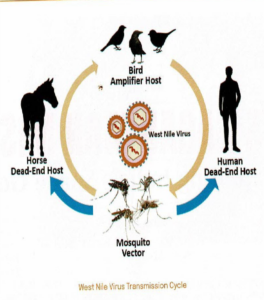
- WNV is sustained in nature through a mosquito-bird-mosquito cycle. Birds serve as the primary reservoir hosts, while mosquitoes, particularly those of the Culex genus, act as vectors, transmitting the virus to humans and other mammals through blood-feeding.
- Mosquitoes become infected by feeding on WNV-infected birds. The virus incubates in the birds’ blood before migrating to the mosquitoes’ salivary glands, enabling the mosquitoes to spread WNV through bites.
- Human infections typically occur during the monsoon season, peaking in summer and early fall when mosquito populations thrive.
Human Infection and Symptoms
- The incubation period of WNV in humans ranges from 3 to 14 days. While humans, horses, and other mammals are considered ‘dead-end’ hosts, unable to transmit the virus to other mosquitoes, WNV can still be spread through blood transfusions and organ transplants.
- Limited reports suggest potential transmission from mother to newborn via intrauterine routes or breastfeeding. Infection with WNV is asymptomatic for most individuals or causes mild flu-like symptoms.
- However, severe cases can lead to neuroinvasive disease, including encephalitis (brain inflammation) and acute flaccid paralysis.
- Symptoms of severe infection include high fever, disorientation, headaches, neck stiffness, blurred vision, stupor, convulsions, and muscle weakness.
- The elderly and immunocompromised individuals are particularly vulnerable to severe outcomes.
Immune Response and Management
- Upon viral invasion, the body initiates a cascade of immune responses involving both innate and adaptive mechanisms. These defenses aim to neutralize the virus but can also contribute to tissue damage, exacerbating neurological complications.
- Understanding the balance between viral clearance and immunopathology is crucial for developing effective therapeutic interventions. Currently, supportive care is the cornerstone of West Nile fever management, as there are no specific antiviral treatments or vaccines for WNV infection.
- Rest, healthy fluid intake, and over-the-counter pain medications may alleviate some symptoms.
Prevention and Future Research
- Preventing WNV infection relies on raising awareness and adopting effective precautions, especially during peak mosquito activity seasons. Wearing protective clothing, using mosquito nets and repellents, and maintaining clean living environments are essential measures.
- The elusive nature of WNV underscores the importance of ongoing surveillance and research to stay ahead of its spread.
- Continued efforts are needed to develop targeted therapies and vaccines, ensuring better preparedness and response to future outbreaks.
ARTICLE 4
A new moreshwar keratin beetle discovered in India

Discovery of a New Beetle Species in India
- A new beetle species has been discovered in India and documented in the New Zealand-based peer-reviewed journal Zootaxa. This discovery continues last year’s identification of the beetle Omorgus (Omorgus) Khandesh.
- The newly discovered species, named Omorgus (Afromorgus) moreshwar, was found in the western part of Maharashtra state.
- With this addition, the number of beetle species in the subgenus Afromorgus in India has increased to ten.
- This beetle is significant for forensic science as it aids in determining the time of death of animals or humans.
Importance in Forensic Science
- Beetles from the family Trogidae, known as keratin beetles, play a crucial role in forensic science due to their necrophagous nature.
- These beetles arrive during the final stages of decomposition, feeding on keratin. The newly discovered Omorgus (Afromorgus) moreshwar belongs to this family.
- In forensic investigations, the presence of these beetles can help estimate the time of death, as they are part of the final successional stage of decomposition.
Taxonomic Updates and Catalogue
- The paper also provides an illustrated catalogue of all 22 valid species of the subgenus Afromorgus from the Oriental and Palaearctic Regions, including taxonomic updates.
- This resource aims to assist new researchers in studying these less-explored beetle groups in India. Dr. Aparna Kalawate from the Zoological Survey of India’s Western Regional Centre in Pune highlighted the importance of this catalogue for budding researchers.
Characteristics and Similar Species
- Beetles of the Trogidae family, sometimes called hide beetles, tend to burrow under the soil.
- They are typically black or grey with a bumpy appearance and dense setae. The new species, Omorgus (Afromorgus) moreshwar, is most similar to Omorgus (Afromorgus) desertorum.
- The paper redescribes and elevates Omorgus (Afromorgus) desertorum from a subspecies to a species, aiding in the accurate identification of both species.
Contribution to Ecology and Future Research
- Trogid beetles are associated with mammal nests or burrows and are known for their role in cleaning the ecosystem by consuming carcasses. Their presence can be crucial for forensic scientists in calculating the time of death of organisms.
- Dr. Aparna Kalawate, the first Indian scientist working on trogid beetles, has described two new species. She emphasizes the need to conserve these beetles and raise public awareness about their importance.
- Dr. Aparna aims to document more species from this understudied group in India, a country rich in biodiversity with many species yet to be discovered.
ARTICLE 5
ISRO’S GAGANYAAN MISSION
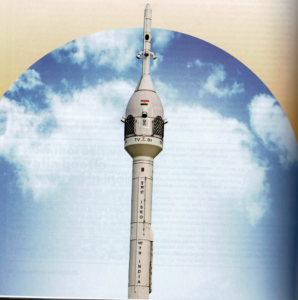
Introduction
- India is gearing up for a significant milestone in its space exploration journey with the Gaganyaan Mission, the country’s first-ever crewed space mission.
- This ambitious project will showcase India’s space capabilities on a global scale, positioning the nation alongside those with human spaceflight capabilities.
- The Gaganyaan mission has garnered international attention and is set to elevate India’s status in the global space community.
Mission Overview
- The Gaganyaan project is a massive undertaking that aims to send four crew members into space for a three-day mission, demonstrating India’s technological prowess.
- This mission involves the collaboration of Indian scientists, engineers, industry, academia, and international partners. Key technologies being developed include a human-rated launch vehicle, life support systems, emergency escape plans, and crew management systems, ensuring the mission’s success.
Launch and Preparations

- The mission will launch from the Satish Dhawan Space Centre (SDSC) in Sriharikota, Andhra Pradesh, which provides the necessary infrastructure and facilities for such a significant mission.
- To prepare for the mission, ISRO has been conducting unmanned test flights to validate technologies and systems.
- The dream of sending Indians to space has been long-standing, with ISRO laying the groundwork through crucial technological advancements over the years.
Technological Developments
- The Gaganyaan mission involves the development of several advanced technologies to ensure safety and success.
- These include man-rating technology for the launch vehicle, crew abort and escape systems, crew recovery technologies, and an Environmental Control and Life Support System (ECLSS) for astronaut comfort and survival.
- ISRO has emphasized indigenous development and collaboration with local industries to pioneer new technologies for astronaut safety and mission success.
The Orbital Module

- The Orbital Module (OM) is a crucial spacecraft component that will orbit Earth.
- It consists of the Crew Module (CM), designed for the crew’s safety and comfort, and the Service Module (SM), which supports the CM in orbit with essential systems.
- The Human Rated LVM3 (HLVM3) rocket will launch the OM into a Low Earth Orbit of 400 km, featuring advanced safety measures, including a Crew Escape System (CES).
Astronaut Training

- The selected astronauts for the Gaganyaan mission are highly skilled test pilots from the Indian armed forces, trained at the Yuri Gagarin Cosmonaut Training Center in Russia.
- They have undergone rigorous physical and psychological testing, along with specialized training in zero gravity environments.
- This training includes classroom instruction, simulation training, and parabolic flights to prepare them for the challenges of space travel.
Ensuring Astronaut Safety
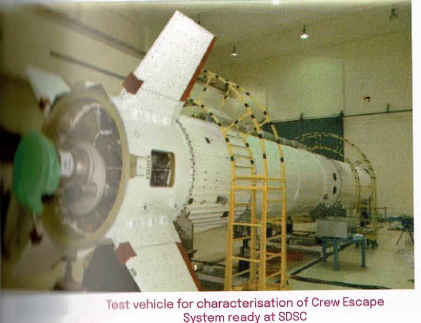
- ISRO is committed to ensuring the safety of the astronauts through meticulous pre-mission preparations.
- Safety measures include abort and escape systems during launch and recovery systems during descent. The ECLSS system is being developed to ensure crew safety in orbit.
- ISRO’s focus on skill-building and design enhancement aims to protect astronauts from potential failures and ensure mission success.
Potential Benefits and Scientific Outcomes
- The Gaganyaan mission holds high hopes for advancing India’s space sector. Potential benefits include deep technology applications with spin-off potential in communication, navigation, and remote sensing.
- The mission will also explore microgravity experiments in biology and agriculture, providing unique opportunities for studying biological processes in space.
- Additionally, high-end sensors used for real-time health monitoring of astronauts could have applications in healthcare and emergency response on Earth.
Conclusion
- The successful completion of the Gaganyaan mission will mark a historic moment for India, showcasing its capabilities in space technology and exploration.
- It will inspire a new generation of scientists, engineers, and innovators, fostering a culture of scientific curiosity and technological advancement. As India embarks on this historic journey, the world will witness its rise as a formidable player in space exploration.
ARTICLE 6
Origin of Life in the Universe
Fascination with the Universe’s Origins
- Mankind has always been captivated by the origins of the universe. Science endeavors to illustrate life’s processes and evolution through the laws of biology and physics.
- Life as we know it is based on chains of carbon atoms, along with other essential atoms like nitrogen and phosphorus, which form the building blocks of DNA molecules that carry genetic information.
- These atoms have been present in the universe in the right amounts and at the right times to foster life. Our planet, orbiting the Sun, formed about 4.6 billion years ago from a collapsing solar nebula.
- Planets, including Earth, were created from rocky, dusty, and gaseous materials in a disk around the nascent Sun, composed of elements such as carbon, nitrogen, oxygen, and heavier elements like silicon, magnesium, potassium, and iron.
The Life Cycle of Stars
- The Sun, like other stars, has a finite lifetime. In approximately 5 billion years, it will expand to become a giant star, engulfing nearby planets and marking the end of its life.
- The journey from simple molecules to intelligent life forms takes a significant portion of the Sun’s total lifetime.
- Thus, the atoms of life must have been produced long before the Sun’s origin. The evolution of the universe, according to modern cosmological theories, began with the Big Bang around 13.8 billion years ago, marking the origin of time, space, and matter.
Expansion of the Universe
- We live in an expanding universe filled with trillions of galaxies, each containing billions of stars. Space is continuously expanding, causing galaxies to move away from each other. This phenomenon, known as cosmic expansion, can be reversed theoretically, leading to a contraction where galaxies converge.
- The universe, in its early stages, was a dense, hot state. Stephen Hawking and Roger Penrose’s theorems on general relativity indicate that a shrinking universe would reach a point of infinite density and temperature, known as a singularity.
- Hawking demonstrated that time, space, and matter originated from this singularity, leading to the colossal expansion known as the Big Bang.
Birth of the First Atoms
- Post-Big Bang, the universe was so hot that all matter existed as elementary particles and radiation. These particles rapidly exchanged energy, maintaining thermal equilibrium.
- Initially, neutrons and protons existed in equal numbers, but as the universe cooled to about 1 billion degrees Kelvin, neutrons began decaying into protons. However, capture reactions between protons and neutrons formed light nuclei such as deuterium, helium isotopes, and lithium within minutes of the Big Bang.
- The universe’s cooling eventually allowed protons and electrons to form neutral hydrogen atoms around 380,000 years after the Big Bang, leading to the formation of the first atoms.
Cosmic Microwave Background Radiation (CBR)
- The primordial radiation remained in thermal equilibrium with protons and electrons until the universe cooled enough for neutral hydrogen atoms to form.
- This decoupling resulted in the Cosmological Background Radiation (CBR), detected on Earth in 1965 and later measured by satellites like COBE and WMAP.
- These observations confirmed the Big Bang model, with the CBR exhibiting temperature variations indicative of the early universe’s matter distribution.
Formation of the First Stars

- The first stars, formed from dense regions of primitive hydrogen gas, appeared within the first 100 million years of the Big Bang. These stars, much more massive and luminous than the Sun, synthesized heavy elements such as carbon, oxygen, and nitrogen.
- Their short lifespans (10-100 million years) ended in supernova explosions, enriching the interstellar medium with heavy elements, which later formed new stars and planetary systems.
- Observations by the James Webb Space Telescope (JWST) revealed carbon-rich galaxies from when the universe was just 600 million years old, indicating the early formation of life’s seed elements.

From Uniformity to Life
- The universe began with tiny fluctuations in density, leading to the formation of stars and galaxies within 200 million years of the Big Bang.
- Gravity amplified these fluctuations, transforming the initially uniform universe into one filled with stars and planets, making it conducive to life.
- This process connected the primordial vibrations to the first carbon atoms, rooting biology in the Big Bang itself.
Preciousness of Life
- Life appeared early in the universe’s history as an outcome of cosmic evolution. Carbon atom production occurred in first-generation stars within the primitive galaxies, separated by billions of light years in today’s universe.
- While carbon-based life forms might be common, the development of intelligent beings like us is rare. It took about 11.5 billion years for intelligence to emerge after the formation of the first stars.
- As Stephen Hawking suggests, intelligence is a rare outcome, underscoring the preciousness of our existence in the universe.
ARTICLE 7
REVOLUTIONISING AEROSPACE: Wood Composites Elevate Aerospace Innovation

Introduction to Wood Composites in Aerospace
- In recent years, the aerospace industry has been exploring novel materials and manufacturing techniques to enhance aircraft performance, reduce environmental impact, and promote sustainability.
- Among these advancements is the re-emergence of wood composites as a viable alternative to traditional materials like aluminum, titanium, and carbon fiber.
- Despite common assumptions, wood possesses unique qualities that make it an appealing option for aerospace applications when paired with current technical processes and sophisticated treatments.
Historical Use and Modern Challenges
- Wood composites were historically used in aircraft construction, notably during the early days of flight. However, modern commercial airplanes predominantly utilize materials such as aluminum alloys, carbon fiber composites, and titanium due to their superior strength, durability, and weight-saving properties.
- While wood composites offer benefits like being lightweight and having strong thermal and acoustic insulation capabilities, they face significant challenges related to structural integrity, fire resistance, and moisture absorption.
- Consequently, wood composites have been deemed less suitable for contemporary airplanes where safety and performance are paramount.
Recent Innovations in Wood Composites
- Despite these challenges, there have been significant advancements in using wood composites in aviation, particularly in prototype and experimental aircraft.
- Advanced manufacturing techniques can enhance the strength and durability of wood composites. These materials are increasingly used in non-structural aircraft components, such as cabin interiors, where their aesthetic attributes and insulating properties are advantageous.
- Wood veneers or wood-based laminates might be used in certain circumstances to provide visually appealing surfaces.
Applications of Wood Composites in Aerospace
Wood composites, also known as wood-based composites or engineered wood products, are made by combining wood fibers or particles with adhesives or bonding agents to produce a material with enhanced mechanical properties and performance traits. These composites offer a mix of strength, stiffness, cost-effectiveness, and durability, making them suitable for various applications in the aerospace industry:
- Interior Cabin Components: Wood composites are used in aircraft interior cabin components like wall panels, flooring, seat frames, and overhead compartments. Their aesthetic appeal, acoustic insulation, and lightweight attributes make them ideal for creating a cozy and pleasant cabin environment.
- Non-Structural Aircraft Components: Fairings, internal walls, and decorative features in aircraft have been made using wood composites. Their adaptability, low cost, ease of production, and strong vibration dampening capabilities make wood composites suitable for these applications.
- Small-Scale and Experimental Aircraft: Wood composites are used in constructing small-scale and experimental aircraft, providing a combination of strength, weight, and affordability. This makes them attractive for smaller aircraft designs.
- Unmanned Aerial Vehicles (UAVs): Wood composites are used in UAVs due to their favorable strength-to-weight ratio and ease of modification, making them suitable for lightweight and maneuverable structures.
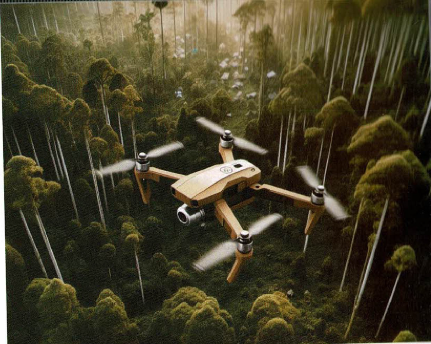
- Rotorcraft Parts: Components like rotor blades and tail fins in rotorcraft can be made from wood composites. With proper coatings and treatments, wood’s strength and stiffness can provide exceptional performance characteristics for rotorcraft parts.
Current Trends and Technologies
The aviation industry is increasingly focusing on recyclable and ecologically friendly materials to reduce its carbon footprint and reliance on petroleum-based products. New and innovative wood-based composites could play a key role in achieving this goal:
- Natural Fiber Polymer Composites (NFPCs): These composites use natural fibers from plants and animals, offering benefits like low density, high strength-to-weight ratio, low cost, and the ability to be used in complex components. They can replace synthetic composites, aiding in “greening” the aerospace sector.
- Nanocellulose-Based Products: Nanocellulose, a material with at least one dimension in the nanoscale, has impressive mechanical strength, biocompatibility, and tailorable surface chemistry. Nanocellulose composites are being developed as reinforcement materials in aircraft structural components, potentially reducing aircraft weight and improving fuel efficiency. Nanocellulose aerogels and microfibrillated cellulose (MFC) are also being explored for their potential use in lightweight, high-strength composite structures in the aerospace industry.
Challenges and Considerations
- While natural fibers offer benefits when used in composites, they also pose challenges in processing, performance, and compatibility with polymeric matrix systems.
- Natural fibers may not provide consistent physical attributes across different harvesting seasons and regions due to varying environmental conditions.
- Additionally, their incompatibility with various polymeric matrices can lead to uneven distribution of fibers within the matrix. Most polymers, particularly thermoplastics, are nonpolar (hydrophobic) substances, further complicating their integration with natural fibers.
Conclusion
- The aerospace industry is witnessing a resurgence in the use of wood composites, driven by advancements in manufacturing techniques and a growing emphasis on sustainability.
- While wood composites face challenges, their unique qualities, environmental sustainability, and potential financial advantages make them a promising material for specific aerospace applications.
- As research and development continue, wood composites may play a more significant role in the future of aviation.
ARTICLE 8
High Altitude Platform Vehicle Redefines Aerial Surveillance
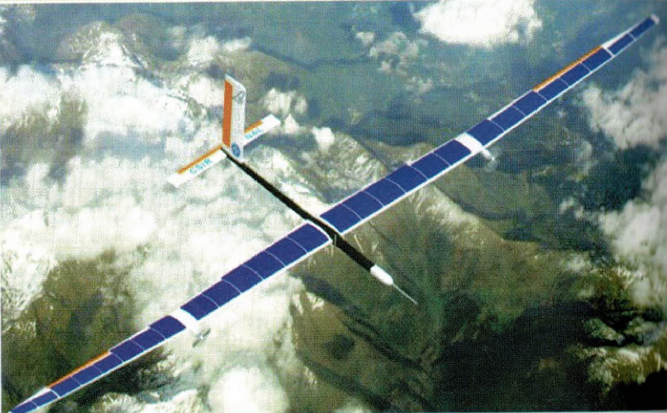
Introduction to High Altitude Platform (HAP) Vehicle
- CSIR’s National Aerospace Laboratories (NAL), based in Bengaluru, has introduced an innovative deep technology known as the High Altitude Platform (HAP) vehicle.
- This solar-powered Unmanned Aerial Vehicle (UAV) is designed for beyond Visual Line of Sight operations, positioning itself as a pseudo satellite. The HAP vehicle holds immense potential for various civilian and military applications, including maritime and land surveillance, disaster response, environmental monitoring, and border control.
- Its versatility extends to intelligent transportation systems, emergency communications, search and rescue operations, evidence collection, and early warning systems.
Advancements in HAP Technology
- The development of the HAP vehicle by CSIR-NAL marks a significant milestone for India, placing it among the leading countries in High Altitude Pseudo Satellite (HAPS) technology alongside South Korea and the United Kingdom.
- Operating at altitudes between 18 to 20 kilometers, the HAP provides consistent surveillance and monitoring capabilities using solar power for propulsion and operation.
Successful Flight Trials
- Scientists at CSIR-NAL have conducted successful flight trials for a sub-scale model of the HAPS, a lightweight, solar-powered UAV.
- Between January 23 and February 2, 2024, the prototype with a 12-meter wingspan and weighing less than 22 kilograms was tested at the Defence Research and Development Organisation’s Aeronautical Test Range (ATR) in Challakere, Karnataka.
- The trials simulated real-world conditions, including various payloads and flight systems, and the results exceeded performance benchmarks.
Features and Challenges of HAPs
- Director of CSIR-NAL, highlighted the features and challenges of the HAP vehicle, designed for persistent surveillance at altitudes between 18 to 20 kilometers.
- The vehicle requires very lightweight aerodynamic structures and must be powered by solar energy to remain operational for extended periods. This necessitates the storage of excess energy in high-density batteries for use during nighttime.
- The recent test flight showcased the HAP’s capabilities, demonstrating the feasibility of a lightweight solar-powered UAV for extended high-altitude operations.
Significance of HAPs in Aerospace
- Experts of High Altitude Platform at CSIR-NAL, explains that HAPs operate at an altitude of 20 kilometers in the stratosphere, forming part of a telecommunication or earth observation network.
- This altitude avoids normal flight corridors and weather disturbances. HAPs combine the geographical persistence of a geostationary satellite with the flexibility of re-tasking and redeployment of an aircraft, filling a unique niche between traditional satellites and UAVs.
Challenges and Future Prospects
- HAPs face several challenges, including ensuring sufficient solar power for flight and battery charging for nighttime operations. The extreme temperatures in the stratosphere, reaching minus 50 degrees Celsius, also pose significant operational efficiency and battery performance challenges.
- Experts emphasized the complexity of managing energy resources during flight. The successful development and testing of the HAP vehicle represent a remarkable achievement in aerospace engineering, showcasing India’s capabilities in cutting-edge technology and innovation.
Conclusion
- The successful development of the HAP vehicle by CSIR-NAL highlights India’s advancements in aerospace technology.
- As the capabilities of HAPs continue to be refined and enhanced, their potential to revolutionize aerial surveillance, communication, and monitoring systems becomes more evident.
- Powered by renewable energy sources and capable of operating for extended durations at high altitudes, HAPs represent a new era in aerospace advancement, bridging the gap between conventional UAVs and satellites.
ARTICLE 9
Revolutionising Industries: The Power and Potential of Biomanufacturing
Rapid Expansion of India’s Bioeconomy
- India’s bioeconomy is on a trajectory to reach a $150 billion valuation by 2025, significantly up from $80 billion in 2021-22. The Indian government is actively supporting this growth through its National Biotechnology Development Strategy 2021-25.
- This dynamic sector includes agriculture, pharmaceuticals, food and beverages, chemicals, and energy. India’s robust foundation of skilled scientists, engineers, and an innovation-friendly environment has been instrumental in this expansion.
- The COVID-19 pandemic further accelerated growth, positioning India at the forefront of vaccine and biopharmaceutical production.
The Role of Biomanufacturing
- Biomanufacturing, which leverages biological systems to produce marketable products, is central to advancing India’s bioeconomy.
- It promises to reduce reliance on imported bio-based commodities while generating jobs, revitalizing the economy, preserving the environment, and fostering innovation to address global challenges like climate change and food security.
- The Department of Biotechnology (DBT) has emphasized transforming India into a biomanufacturing hub, reflecting the sector’s strategic importance.
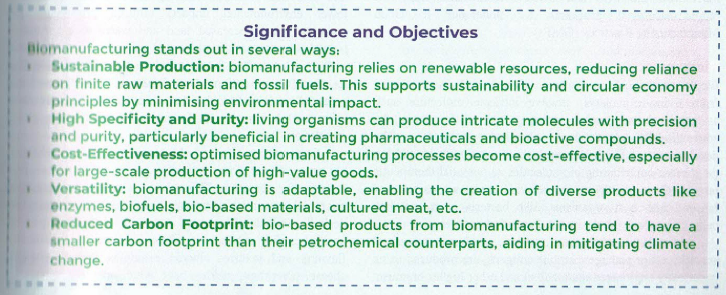
Historical Development and Milestones
Biomanufacturing has evolved significantly since ancient times when fermentation processes were used to produce food and beverages. The development of new technologies can be categorized into four phases:

- Biomanufacturing 1.0 focused on primary metabolites like alcohols through mono-culture fermentation, initiated during World War I.
- Biomanufacturing 2.0 advanced to secondary metabolites like penicillin, discovered by Alexander Fleming in 1928, using aerobic submerged liquid fermentation.
- Biomanufacturing 3.0 introduced large biomolecules such as proteins and enzymes, facilitated by recombinant DNA technology in the 1970s.
- Biomanufacturing 4.0 embraces cutting-edge technologies like regenerative medicine, offering potential for organ transplantation and personalized treatments.
Principles of Biomanufacturing
- The success of biomanufacturing depends on selecting appropriate host organisms, such as bacteria, yeasts, fungi, and mammalian cells, which are genetically modified to produce specific products.
- Genetic engineering and synthetic biology are key techniques, allowing for the alteration and design of biological systems.
- Quality control, adherence to safety protocols, and regulatory oversight ensure the efficacy and safety of biomanufactured products.
Biomanufacturing in Pharmaceuticals
- Biopharmaceuticals, derived from living organisms, include complex molecules like proteins and nucleic acids. The development process involves identifying therapeutic targets, cloning genes, and producing the desired biomolecules in host organisms.
- Monoclonal antibodies, produced using genetically engineered cells, are effective against various diseases due to their high specificity. Biomanufacturing also supports large-scale vaccine production, including recombinant subunit and mRNA vaccines.
- Therapeutic proteins and advanced gene and cell therapies are other critical outputs, offering treatments for previously incurable conditions.
Biomanufacturing in Food and Beverages
- Biomanufacturing has significantly impacted the food industry by developing alternative protein sources and sustainable food production methods.
- Plant-based proteins and cultivated meat provide eco-friendly and ethical substitutes for conventional meat. Fermentation, a long-standing technique, continues to be vital, producing health-beneficial foods and beverages with unique flavors and textures.
- Bioactive compounds derived from microorganisms enhance food quality and nutritional value.

Energy and Sustainable Fuels
- Biomanufacturing is crucial in producing renewable biofuels, reducing dependence on fossil fuels.
- Bioethanol and biodiesel are prominent examples, derived from plant materials and oils through fermentation and transesterification processes.
- Biomanufacturing also supports biogas and biohydrogen production from organic matter, offering clean energy alternatives for various applications.
Environmental Protection through Biomanufacturing
- Biomanufacturing advances biodegradable materials, providing eco-friendly alternatives to traditional plastics.
- Bioplastics and biodegradable medical devices reduce waste and promote a circular economy.
- Bioremediation strategies utilize microorganisms to clean pollutants, while engineered enzymes help degrade plastic waste.
-
Biosensors, using biological components, detect environmental pollutants, aiding in pollution control and biodiversity assessment.
ARTICLE 10
AI Revolutionising Drug Discovery
-
AI’s transformative potential in drug discovery is underpinned by its extensive data repository, enabling innovative solutions.
- AI’s ability to establish correlations using novel datasets allows researchers to integrate them across various segments of the drug discovery pipeline. This capability significantly impacts several key areas:
Target Identification
- Target identification is crucial in drug discovery, involving the identification and validation of potential targets, such as biological entities or processes modifiable through pharmacological intervention.
- Historically, this process faced lengthy and unpredictable timelines due to reliance on empirical observations and chance discoveries. AI, leveraging extensive biological data and its processing adeptness, enables the use of multidimensional datasets to pinpoint potential therapeutic targets with exceptional precision.
- Predictive techniques help evaluate and validate these targets early in drug discovery, reducing costs and timelines while improving success rates.
Drug Design
- Drug design is another vital aspect, typically involving labor-intensive screening of compound libraries to identify potential drug candidates. Minimizing side effects and toxicological risks is essential.
- AI automates this process, exploring vast chemical spaces and predicting new molecules’ properties with precision. This automation accelerates screening, enhances candidate selection accuracy, and facilitates designing novel therapeutics by identifying drug candidates for target proteins.
- AI addresses the high rejection rate of drug candidates during trials, making the process more efficient and effective.
Drug Repurposing
- Drug repurposing, highlighted during the COVID-19 pandemic, involves using existing drugs to treat new diseases. AI can expedite this process by predicting hidden relationships between existing drugs and diseases, offering innovative therapeutic solutions for unresolved medical conditions.
- This approach saves time and money by reducing the need for developing new drugs and addressing multiple diseases effectively.
Combination Therapies
- Combination therapy, or polytherapy, uses more than one medication or modality, especially for treating complex diseases like cancer. The expectation is that drug combinations will enhance each other’s potency and effectiveness.
- Despite its complexity, AI, equipped with extensive biomedical data, can identify synergistic drug combinations, predict their binding capabilities, and overall impact on target proteins.
- This leads to new therapeutic interventions tailored to emerging medical challenges.
Predictive Modelling and Simulation
- Predictive modeling and simulation offer better understanding of complex chemical compounds. Traditional methods struggle with capturing the complexity of biological systems and integrating diverse data like ethnicity, age, and gender.
- AI improves by simulating drug-protein interactions and accurately predicting molecule behavior. Machine learning models enable the integration of diverse data sources, enhancing the research process and guiding drug selection efficiently.
- AI’s collaboration with pharmaceutical experts ensures more effective use of AI-derived insights, optimizing drug discovery outcomes.
Challenges Faced by AI in Drug Discovery
- Despite its promise, AI faces challenges in drug discovery. Access to extensive datasets is crucial, but data availability and quality issues persist. The pharmaceutical industry’s regulated and organized environment demands transparency in AI-driven solutions.
- AI models are complex, computationally intensive, and expensive to run, posing resource challenges. Additionally, the environmental impact of AI, due to high water and electricity consumption, necessitates sustainable AI development.
- Regulatory backlash and the need for domain-specific knowledge further complicate AI implementation.
Future Prospects and Collaboration
- The pharmaceutical industry’s historical reluctance to embrace new technologies, due to regulatory complexities and substantial financial investments, presents a barrier to AI adoption. However, AI’s potential extends beyond drug discovery to allied fields like medicinal chemistry and personalized medicine.
- AI can predict absorption, distribution, metabolism, and excretion properties of materials, prioritize virtual screening prospects, and optimize multiple design parameters. In structure-based design, AI predicts binding affinity and interactions between molecules and target proteins. In ligand-based design, generative models map chemical and biological activity correlations.
- AI’s capability in De-Novo design to generate new chemicals based on required properties also shows promise.
ARTICLE 11
Comprehending The Intelligent Cichlids
Distribution and Diversity of Cichlids
- Cichlid fishes, belonging to the family Cichlidae and order Cichliformes, are renowned for their intelligence. These freshwater fishes are occasionally found in brackish water and are distributed across Central and South America, the West Indies, Africa, Madagascar, Israel, Syria, coastal India, and Sri Lanka.
- Cichlidae is one of the most species-rich families in freshwater environments globally, with 1,762 recognized species. Endemic cichlids dominate the fish fauna in the three African lakes with the highest species diversity: Lake Malawi, Lake Victoria, and Lake Tanganyika.
Cognitive Abilities of Cichlids
- Cichlids are considered highly intelligent due to their high performance in problem-solving, social behavior, learning, memory, and adaptability to changing environments.
- Cichlids exhibit complex behaviors, have relatively large brains, and can learn and remember intricate tasks. They can recognize their owners, use tools, and perform tricks to achieve their goals.
- Notably, cichlids demonstrate the ability to use transitive inference, similar to some higher vertebrates.
- Environmental changes, such as variations in food ration early in life, have been shown to enhance their cognitive abilities later.
Behavioral Displays of Intelligence
- Cichlids exhibit several behaviors that indicate their intelligence. Males of many mouth-brooding cichlids build sand cones to attract females.
- Some species, like the red-spotted cichlids, playfully hit floating objects to make them wobble.
- Predatory cichlids in Lake Malawi display death feigning to attract prey, remaining motionless to mimic rotting carcasses and then attacking inquisitive fish. These behaviors reflect their advanced cognitive capabilities and adaptability.
Notable Intelligent Cichlid Species
Certain cichlid species stand out for their intelligence:
- Convict Cichlid (Amatitlania nigrofasciata): Known for complex social behaviors and problem-solving skills. They communicate using various cues, clean a place for spawning, and adapt well to different environments.

- Frontosa Cichlid (Cyphotilapia frontosa): Exhibits complex social behavior, tool use, and strong problem-solving abilities. They defend territories and mouthbrood their young.

- Angelfish (Pterophyllum species): Known for quick learning and intelligence.

- Discus (Symphysodon species): Social, intelligent, and capable of recognizing faces. Female discus fish secrete a milk-like substance to nurse their young.
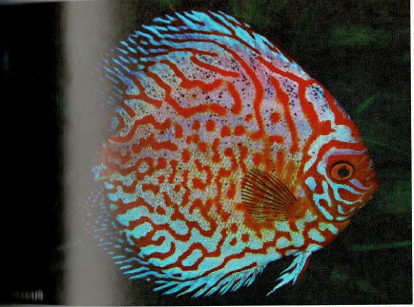
- Oscar (Astronotus ocellatus): Adaptable, able to learn tricks, and perform for their owners. They clean spawning sites and excavate nests.

- Green Terror (Andinoacara rivulatus): Attentive and protective of their young, these cichlids choose and clean flat rocks for egg-laying.

Care and Stimulation for Cichlids
- For optimal brain function, cichlids require a proper, healthy diet and plenty of mental stimulation. Providing toys, puzzles, and games that challenge their problem-solving abilities is crucial.
- In aquariums, cichlids should have diverse environments with plants, rocks, hiding places, and new things to explore to keep them mentally and physically active.
- Ensuring these conditions helps maintain their cognitive abilities and overall well-being.
NEWS IN BRIEF
1) University of Tokyo Develops Breakthrough Soft X-Ray Microscope for Live Cell Imaging

- Researchers from the University of Tokyo have developed a new soft X-ray microscope that allows for the visualization of live mammalian cells and carbon structures within them.
- Using a powerful soft X-ray free electron laser, the microscope emits ultrafast pulses at femtosecond speeds, enabling the capture of images before radiation damage occurs.
- The team created refined Wolter mirrors, ultraprecise mirrors that provide high spatial resolution and a wide field of view, making this breakthrough possible.
- This advanced microscope is expected to enhance understanding of the dynamic nature of cellular biology. The research findings were published in Optica.
2) University of Bath Unveils DeformlO: Revolutionary Touch Screen That Adapts to Pressure

- Researchers from the University of Bath have developed DeformlO, a touch screen for digital devices that can change its stiffness in response to finger pressure.
- Made of silicone, DeformlO uses pneumatics and resistive sensing to detect pressure, allowing users to press and feel the screen, creating a more natural interaction.
- This advancement promises to transform our experience with screens. The research was published in the Association for Computing Machinery.
3) Breakthrough Biodegradable Microdroplets for Disease Detection and Reprogrammable Skin-Attachable Health Monitor Developed

- Researchers from Nanyang Technological University (NIU), Singapore, developed biodegradable microdroplets that can travel through the bloodstream and detect disease biomarkers, such as exosomes, using laser light.
- These microdroplets, about one-third the diameter of a human hair, create stronger and more precise signals when hit by laser light, allowing for accurate detection of diseases.
- The microdroplets are customizable, flexible, and safely absorbed by the body. This research was published in Nano Letters.
4) Advanced Skin-Attachable Device and Biodegradable Microdroplets Developed for Precise Health Monitoring and Disease Detection

- Researchers from Pennsylvania State University have developed a skin-attachable, reprogrammable adhesive device that can monitor health indicators such as sweat pH, glucose, lactate levels, heart rate, and nerve performance in real-time.
- The device remains effective even on wet or sweaty skin and can detect diseases by monitoring viral protein biomarkers.
- Additionally, the device utilizes biodegradable microdroplets, which are capable of traveling through the bloodstream to detect disease biomarkers like exosomes.
- These microdroplets enhance signal detection through laser light interaction, leading to more precise health monitoring. This research was reported in Advanced Materials.



